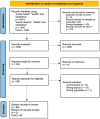The Use of Social Media in Children and Adolescents: Scoping Review on the Potential Risks
- PMID: 36011593
- PMCID: PMC9407706
- DOI: 10.3390/ijerph19169960
The Use of Social Media in Children and Adolescents: Scoping Review on the Potential Risks
Abstract
In recent years, social media has become part of our lives, even among children. From the beginning of COVID-19 pandemic period, media device and Internet access rapidly increased. Adolescents connected Internet alone, consulting social media, mostly Instagram, TikTok, and YouTube. During "lockdown", the Internet usage allowed communication with peers and the continuity activities such as school teaching. However, we have to keep in mind that media usage may be related to some adverse consequences especially in the most vulnerable people, such as the young. Aim of the review is to focus on risks correlated to social media use by children and adolescents, identifying spies of rising problems and engaging in preventive recommendations. The scoping review was performed according to PRISMA guidelines, searching on PubMed the terms "social media" or "social network", "health", and "pediatrics". Excluding articles not pertinent, we found 68 reports. Out of them, 19 were dealing with depression, 15 with diet, and 15 with psychological problems, which appeared to be the most reported risk of social media use. Other identified associated problems were sleep, addiction, anxiety, sex related issues, behavioral problems, body image, physical activity, online grooming, sight, headache, and dental caries. Public and medical awareness must rise over this topic and new prevention measures must be found, starting with health practitioners, caregivers, and websites/application developers. Pediatricians should be aware of the risks associated to a problematic social media use for the young's health and identify sentinel signs in children as well as prevent negative outcomes in accordance with the family.
Keywords: COVID-19; adolescents; children; health; social media; social network.
Conflict of interest statement
The authors declare no conflict of interest.
Figures

References
-
- Cittadini e ICT. [(accessed on 17 July 2022)]. Available online: https://www.istat.it/it/archivio/236920.
-
- Censis. Quarto Rapporto Auditel Censis. Nov 19, 2021. [(accessed on 19 July 2022)]. Available online: https://www.censis.it/
-
- Tra-Digitale-e-Cyber-Risk-MOIGE-1.Pdf. [(accessed on 10 July 2022)]. Available online: https://www.moige.it/wp-content/uploads/2021/02/Tra-digitale-e-cyber-ris....
Publication types
MeSH terms
LinkOut - more resources
Full Text Sources
Medical

